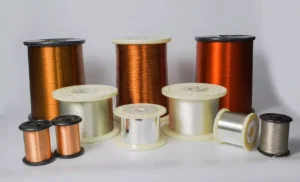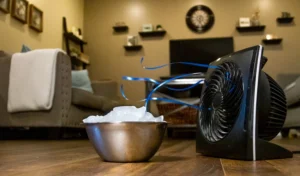Introduction
In our quest for comfort, especially during those scorching summer days or humid nights, fans have become an indispensable part of our daily lives.
From homes and offices to commercial and industrial spaces, the humble fan stands as a symbol of simple yet effective technology for air circulation and cooling.
Not only are fans cost-effective and energy-efficient, but they also come in a plethora of styles and sizes, catering to various needs and preferences.
Pedestal Fans

Pedestal fans, also known as stand fans, are a popular choice for effective and portable cooling.
These fans are particularly versatile due to their adjustable height and ability to be moved easily from one location to another.
They are ideal for use in various settings, including homes, offices, workshops, and outdoor areas.
Features and Design
- Adjustable Height: One of the key features of pedestal fans is their adjustable stands, which allow the height of the fan to be altered to suit the user’s needs. This feature makes them suitable for a wide range of environments.
- Oscillation and Tilt: Most pedestal fans come with an oscillation feature, enabling them to rotate side-to-side and cover a wider area. Additionally, the ability to tilt the fan head up or down ensures directed airflow where it’s needed most.
- Blade Size and Power: Pedestal fans typically have larger blades compared to table fans, contributing to their ability to circulate air effectively in larger spaces. The motor power of these fans can vary, with more powerful fans providing more significant airflow.
Portability and Convenience
- Easy to Move: Unlike ceiling or wall-mounted fans, pedestal fans are not fixed to one spot, making them easy to relocate. This portability is particularly beneficial in homes or spaces where permanent fan installation is not feasible.
- Space-Saving Design: Despite their powerful performance, pedestal fans generally have a compact base, ensuring they don’t occupy too much floor space.
Usage Scenarios
- Indoor and Outdoor Use: Perfect for indoor use in living rooms, bedrooms, or offices, pedestal fans are also robust enough for outdoor use on patios or balconies.
- Large Room Cooling: Their ability to move a substantial amount of air makes them ideal for larger rooms or spaces where centralized cooling may not reach effectively.
Customization and Control
- Speed Settings: Multiple speed settings on pedestal fans allow users to control the airflow intensity, making it easier to achieve the desired comfort level.
- Remote Control and Timers: Many modern pedestal fans come with remote controls for convenience, and some models feature timers, allowing users to set operating times according to their needs.
Considerations
- Stability: It’s important to ensure that the fan’s base is stable to prevent it from tipping over, especially in busy or crowded areas.
- Maintenance: Regular cleaning of the blades and guard is necessary to maintain optimal performance and prolong the life of the fan.
Table Fans/Desk Fans
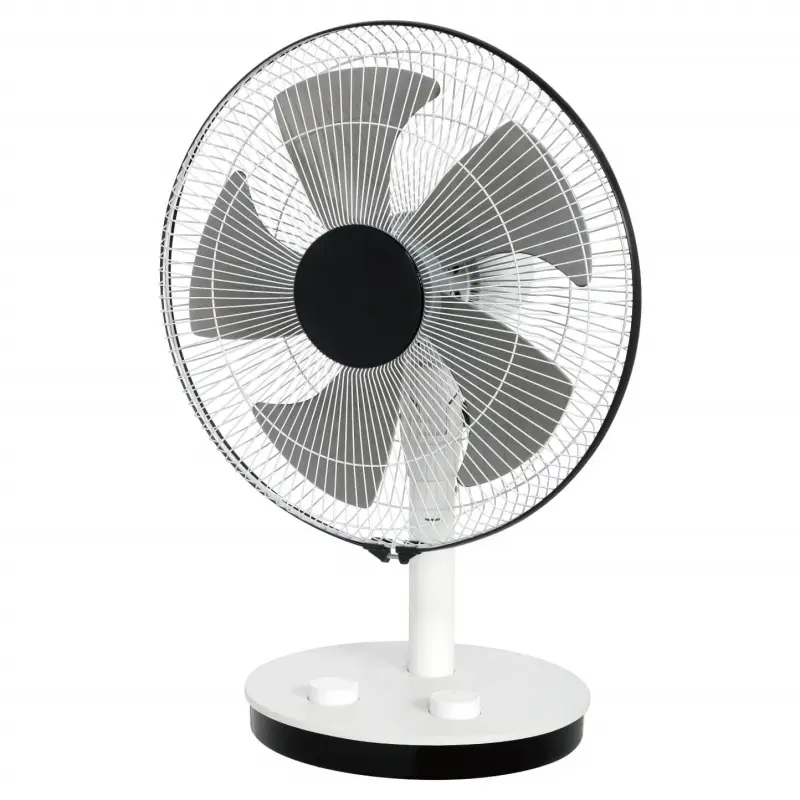
Table fans, also known as desk fans, are compact and portable cooling devices, ideal for personal use. They are designed to be placed on tables, desks, or any flat surface, providing direct airflow to a specific area.
Their small size and efficiency make them a popular choice in homes, offices, and dorm rooms.
Features and Design
- Compact Size: The most notable feature of table fans is their compactness, making them suitable for small spaces or personal work areas.
- Direct Airflow: These fans provide focused airflow, making them perfect for situations where cooling is needed for a specific area rather than an entire room.
- Variety of Styles: Available in a range of designs and colors, table fans can be selected to match interior decor or personal preferences.
Functionality
- Oscillating Movement: Many table fans come with an oscillation feature, allowing the fan to move side-to-side, thereby increasing the area they can cool.
- Adjustable Tilt: The ability to adjust the tilt of the fan head is useful for directing the airflow precisely where it is needed.
- Speed Settings: Multiple speed settings give users the flexibility to adjust the airflow based on their comfort level and cooling needs.
Convenience and Portability
- Ease of Movement: Being lightweight, table fans can be easily moved from one place to another, offering personalized cooling wherever needed.
- Space Efficiency: Their small footprint makes them an ideal choice for crowded desks, bedside tables, or kitchen counters.
Usage
- Personal Cooling: These fans are best suited for personal use, providing relief from heat in close proximity, such as at a workstation or bedside.
- Supplemental Cooling: In rooms with larger cooling systems, table fans can be used for additional air circulation to avoid hot spots.
Power Options
- Electric Plug-in: Most table fans are powered through a standard electrical outlet, but some newer models offer USB connectivity, allowing them to be powered through computers or power banks.
Considerations
- Noise Level: Depending on the design and quality, some table fans may be noisier than others, which is an important consideration for noise-sensitive environments.
- Durability and Safety: While selecting a table fan, it’s essential to consider the build quality for durability and safety features like a protective grill.
Rechargeable Fans
Rechargeable fans offer the convenience of portability and the flexibility of cordless operation, making them a versatile choice for cooling in a variety of settings.
These fans are equipped with built-in batteries that can be recharged, allowing you to use them anywhere without the need for a continuous power supply.
Features and Design
- Battery-Powered Operation: A defining feature of rechargeable fans is their built-in battery, which allows them to operate without being tethered to a power outlet. This makes them ideal for use in locations where power is not readily available or during power outages.
- Adjustable Speeds: Like pedestal fans, many rechargeable fans come with multiple speed settings, giving you control over the airflow intensity to suit your comfort level.
- Compact and Lightweight: Rechargeable fans are designed to be portable, often featuring a compact and lightweight construction, making them easy to carry and position as needed.
Portability and Convenience
- Ease of Mobility: The cordless nature of rechargeable fans makes them highly portable, allowing them to be easily moved from one location to another, similar to the portability of pedestal fans.
- Multiple Charging Options: These fans can often be charged via various sources, including USB ports, solar panels, or standard electrical outlets, offering flexibility in how and where the fan can be used.
Usage Scenarios
- Outdoor and Travel Use: Rechargeable fans are perfect for outdoor activities, travel, or any situation where traditional power sources are not available or convenient.
- Backup Cooling: They serve as a reliable backup cooling solution during power outages or in areas where power supply is inconsistent.
Customization and Control
- Additional Features: Some rechargeable fans come equipped with extra features such as LED lights, power bank functionality for charging other devices, and even oscillation capabilities to distribute air more evenly across a wider area.
Considerations
- Battery Life: The duration of the fan’s operation depends on the battery capacity and the fan’s speed setting. It’s important to consider the battery life and charging time when choosing a rechargeable fan.
- Power Output: While rechargeable fans are incredibly convenient, their airflow output may not be as powerful as that of larger, mains-powered fans like pedestal fans. This is an important consideration based on the intended use and the size of the area you wish to cool.
- Maintenance: Regular maintenance, including charging the battery and keeping the fan clean, is necessary to ensure the longevity and optimal performance of the fan.
Rechargeable fans stand out for their convenience, portability, and versatility, making them a fantastic choice for personal cooling needs, especially in situations where access to electrical power is limited.
Just like pedestal fans, they offer various features and settings to cater to individual preferences, but with the added advantage of cordless operation.
Whether used indoors, outdoors, or as a backup during power outages, rechargeable fans provide a reliable source of airflow wherever you are.
For a more comprehensive understanding of the benefits and limitations of these versatile cooling devices, consider exploring our detailed article: “Rechargeable Fan: Pros and Cons – The Ultimate Guide“.
Ceiling Fans
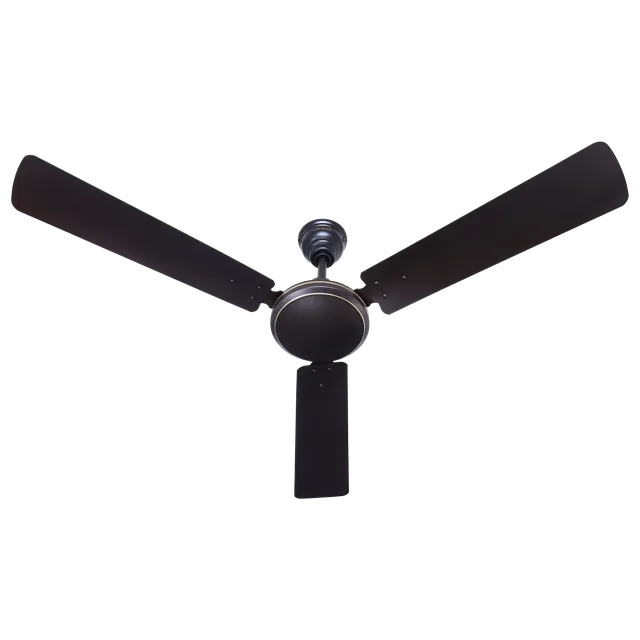
Ceiling fans are perhaps the most ubiquitous type of fan found in homes and offices around the world.
They are installed on the ceiling and provide an effective way of circulating air throughout a room.
The range of ceiling fans available today is vast, catering to various tastes, from traditional designs to modern, sleek styles.
Features and Styles
- Design Variety: Ceiling fans come in a plethora of designs, with options ranging from classic wooden blades to contemporary metal and plastic ones. Some feature decorative elements like lights or unique blade shapes.
- Size and Scale: The size of the fan should correspond to the size of the room for optimal airflow. Larger rooms may require fans with longer blades or even multiple fans.
- Motor Type: Modern ceiling fans come with either AC or DC motors. AC motor fans are common and cost-effective, but DC motor fans are more energy-efficient, quieter, and often include more speed settings.
- Control Options: Traditional fans use pull chains or wall switches, while many modern fans offer remote control for convenience and ease of use. Some even integrate with smart home systems for automated control.
Functionality
- Air Circulation: Ceiling fans help in evenly distributing air throughout a room, making them ideal for large living spaces, bedrooms, or office areas.
- Energy Efficiency: They are an energy-efficient way to cool a room. By circulating air, ceiling fans make the environment feel cooler, allowing you to raise the thermostat setting and save on air conditioning costs.
- Seasonal Versatility: Many ceiling fans come with a reverse rotation feature. In the winter, reversing the fan direction helps circulate warm air that rises to the ceiling, distributing it evenly throughout the room.
Installation Considerations
- Ceiling Height: Ideal for rooms with high ceilings, but low-profile or hugger fans are available for rooms with lower ceilings.
- Installation: While ceiling fans are relatively straightforward to install, it’s crucial to ensure they are properly anchored to avoid wobbling and potential accidents.
- Maintenance: Regular cleaning of the blades and motor, along with occasional checks on the mounting and wiring, will keep the fan in good working condition.
Tower Fans
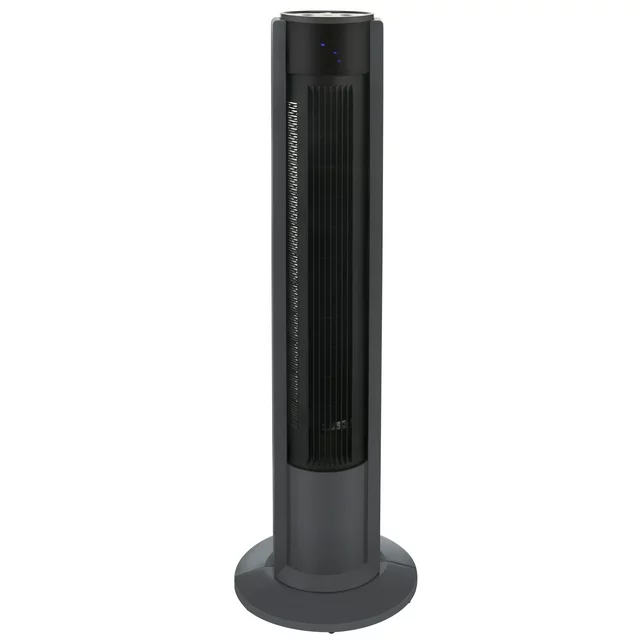
Tower fans are a modern and stylish alternative to traditional fans, known for their slim, vertical design that fits well in contemporary living spaces.
They are particularly favored in apartments, offices, and rooms where space is at a premium.
These fans offer efficient cooling and a range of features that make them a versatile choice for any indoor environment.
Design and Aesthetics
- Sleek Profile: The tall, slender design of tower fans not only saves space but also adds a touch of elegance to any room. Their aesthetic appeal makes them a favored choice for those who value both functionality and style.
- Variety of Sizes and Styles: Available in different heights and designs, tower fans can be chosen to suit the specific decor and spatial constraints of a room.
Features and Functionality
- Oscillation: Most tower fans have an oscillation feature, allowing them to distribute air across a wider area, which is particularly beneficial in larger rooms.
- Multiple Speed Settings: They usually come with various speed settings, providing flexibility to adjust the airflow according to personal comfort levels.
- Advanced Airflow Technology: Some models incorporate advanced technology to generate a more uniform and powerful airflow, making them effective at cooling larger spaces.
Convenience and Comfort
- Remote Control and Digital Display: Many tower fans are equipped with remote controls and digital displays for easy operation, allowing users to adjust settings without having to get up.
- Quiet Operation: One of the standout features of tower fans is their quiet operation, making them suitable for use in bedrooms, offices, or during quiet activities like reading or watching TV.
Additional Features
- Built-in Timers and Modes: Features like timers and different modes (such as sleep or natural breeze modes) offer added convenience and energy efficiency.
- Air Purification: Some tower fans come with built-in air purifiers or ionizers, enhancing the air quality in the room alongside cooling.
Usage and Placement
- Ideal for Small to Medium-sized Rooms: Their design makes them particularly suitable for small to medium-sized rooms where space-saving is crucial.
- Versatile Placement: Due to their sleek design, tower fans can be placed in a variety of locations, including corners, next to furniture, or in tight spaces.
Maintenance and Safety
- Easy to Clean: Most tower fans have removable filters or easy-to-clean surfaces, making maintenance relatively straightforward.
- Safety Features: Their bladeless design (in some models) and secure base make them a safer option, especially in households with children or pets.
Exhaust Fans

Exhaust fans are specialized fans designed to remove excess humidity, odors, and contaminants from indoor spaces.
They are essential in maintaining indoor air quality, particularly in areas like kitchens, bathrooms, and garages.
These fans work by extracting indoor air and expelling it outside, thereby helping to prevent moisture buildup, mold growth, and odor accumulation.
Types and Placement
- Wall-Mounted Exhaust Fans: Commonly installed on the walls of kitchens and bathrooms to remove moist or stale air directly outside.
- Ceiling-Mounted Exhaust Fans: Often used in bathrooms, these fans pull air upwards and are effective in removing hot, humid air that naturally rises.
- Window-Mounted Exhaust Fans: These are placed in windows and are suitable for small rooms or spaces where wall or ceiling mounting is not feasible.
Features and Functionality
- Moisture and Odor Removal: By expelling damp and odorous air, exhaust fans play a crucial role in preventing mold and mildew growth, as well as maintaining a fresh-smelling environment.
- Variable Speeds and Controls: Some models come with adjustable speed settings, allowing users to control the rate of air extraction based on the current needs of the space.
- Automatic Sensors: Advanced models may include humidity sensors or motion detectors, enabling the fan to turn on automatically when moisture levels or occupancy change.
Design and Efficiency
- Low Profile Designs: Many exhaust fans have a discreet appearance, blending seamlessly into the ceiling or wall without disrupting the room’s aesthetic.
- Energy Efficiency: Modern exhaust fans are designed to be energy efficient, with some models equipped with timers or eco-friendly settings to minimize electricity usage.
Considerations for Installation
- Proper Ventilation: It’s important to ensure that the exhaust fan vents to the outside of the building and not into an attic or enclosed space, to effectively remove humid air from the property.
- Size and Capacity: The size of the fan should correspond to the size of the room; larger spaces may require fans with higher extraction capacity.
- Professional Installation: Proper installation is crucial for effective operation and safety, and it is often recommended to have exhaust fans installed by a professional.
Maintenance
- Regular Cleaning: To maintain optimal performance, it is important to clean the fan blades and vents regularly to prevent dust and grime buildup.
- Inspection and Repair: Periodic inspection of the fan and its components, including the venting system, is recommended to ensure long-term functionality.
Wall-Mounted Fans
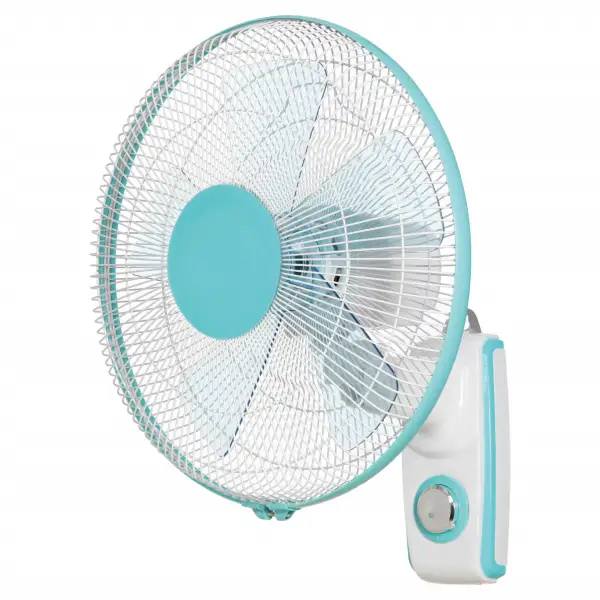
Wall-mounted fans are a practical and space-saving solution for air circulation, especially in areas where floor or table space is limited.
These fans are attached to the wall, making them an ideal choice for compact or crowded spaces such as small offices, workshops, kitchens, or outdoor patios.
Design and Installation
- Space Efficiency: By being mounted on the wall, these fans save valuable floor and table space, making them perfect for cramped or busy areas.
- Adjustable Mounts: Many models come with mounts that allow for adjustment of the fan’s angle, ensuring targeted airflow where it’s most needed.
- Variety of Sizes: Wall-mounted fans are available in various sizes to fit different spaces and airflow requirements.
Features
- Oscillation: Like many other fan types, wall-mounted fans often feature an oscillation function, which helps in distributing air over a wider area.
- Speed Settings: Multiple speed options allow users to control the intensity of the airflow, catering to different comfort levels and room sizes.
- Remote Control and Timers: Some models come equipped with remote controls for convenience, and timers for energy efficiency and ease of use.
Applications
- Versatile Use: These fans are suited for both indoor and outdoor environments, making them versatile for use in homes, offices, workshops, balconies, and patios.
- Effective Air Circulation: They are particularly effective in circulating air in a specific direction or area, such as over a workstation or in a kitchen.
Safety and Durability
- Secure Installation: It is crucial to ensure that the fan is securely mounted to the wall to prevent accidents or damage.
- Durable Construction: Many wall-mounted fans are built to be durable and withstand continuous use, which is essential for fans used in commercial or outdoor settings.
Maintenance
- Ease of Cleaning: The fixed position can make cleaning easier, as the fan can be accessed and cleaned in place without needing to be moved.
- Regular Maintenance: As with all fans, regular checks for dust accumulation, and ensuring that the fan is in good working condition, are important for longevity and performance.
Window, Box, and Cabinet Fans
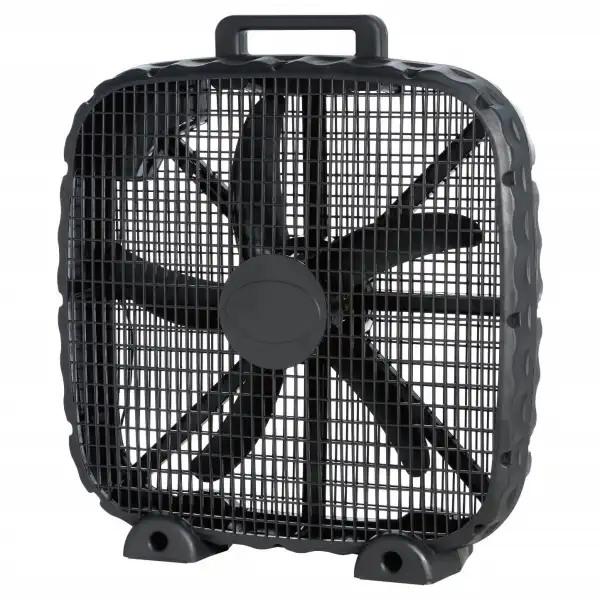
Window, box, and cabinet fans are specialized types of fans designed for specific applications, offering flexibility and targeted cooling solutions in various settings.
Each type serves a unique purpose and is ideal for different scenarios.
Window Fans
Window fans are designed to fit into the frame of a window and are particularly effective in creating cross-ventilation in a room.
- Air Exchange: They work by either bringing in fresh air from outside or by exhausting stale indoor air, depending on their setting.
- Reversible Airflow: Many models offer reversible airflow control, allowing them to function both as an intake and an exhaust fan.
- Adjustable Size: Some window fans have expandable side panels to fit a variety of window sizes.
- Seasonal Use: Ideal for use during cooler times of the day in summer or when the air outside is fresher than indoors.
Box Fans
Box fans are highly portable and versatile, making them a popular choice for on-demand cooling needs.
- Simple Design: Comprising a square or rectangular frame with a central fan, these fans are straightforward in design but effective in function.
- Portability: Lightweight and easy to carry, they can be used in different locations, such as windows, floors, or even mounted in openings.
- Powerful Airflow: Despite their simplicity, box fans can move a significant amount of air, making them suitable for large spaces.
Cabinet Fans
Cabinet fans are typically used in conjunction with heating, ventilation, and air conditioning (HVAC) systems, enhancing the efficiency of these systems.
- Integration with HVAC: They are often installed in ductwork or in spaces where additional air circulation is needed to support the primary HVAC system.
- Specific Cooling Needs: Ideal for cooling electronic components, server rooms, or other areas where heat accumulation is a concern.
- Custom Installation: Often requiring professional installation, these fans are tailored to specific needs and spaces.
Common Features and Considerations
- Energy Efficiency: Many modern models are designed to be energy-efficient, reducing the cost of cooling your space.
- Noise Levels: Depending on the design and model, some of these fans can be quieter than others, an important consideration for bedroom or office use.
- Ease of Use and Maintenance: Look for models that are easy to install, use, and maintain. Regular cleaning and inspection can prolong the life of the fan.
Bladeless Fans
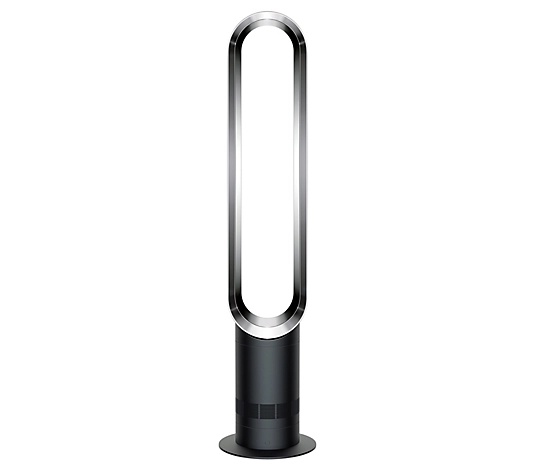
Bladeless fans, a relatively recent innovation in the world of air circulation, are known for their unique design and safe operation.
Despite their name, they do have blades but these are hidden in the base of the fan, making them an aesthetically pleasing and safer alternative to traditional fans.
Design and Aesthetics
- Modern Appearance: Bladeless fans have a sleek, futuristic look that makes them a stylish addition to any contemporary home or office.
- Space-Saving: Their compact and unobtrusive design is ideal for small spaces or minimalistic decor.
Safety and Quiet Operation
- Safer for Children and Pets: With no external blades, bladeless fans are safer around children and pets, reducing the risk of accidents.
- Reduced Noise: These fans are generally quieter than traditional fans, as the blades are enclosed and the air flow is more uniform, making them suitable for bedrooms, study rooms, and offices.
Airflow and Efficiency
- Smooth Airflow: Bladeless fans use air-multiplier technology to create a steady stream of smooth airflow without the choppy effect produced by spinning blades.
- Energy Efficiency: Many models are designed to be energy-efficient, although this can vary depending on the specific design and features.
Features and Functionality
- Variable Speed Settings: Like traditional fans, they often come with different speed settings to adjust the airflow.
- Oscillation and Tilt Functions: Some models offer oscillation and tilt, allowing for broader air distribution and directional control.
- Remote Control and Timers: Advanced models include features like remote control operation and programmable timers for convenience.
Considerations
- Cost: Bladeless fans tend to be more expensive than traditional fans due to their advanced technology and design.
- Maintenance: They require minimal maintenance, usually just regular wiping to keep them dust-free.
- Air Purification: Some high-end models even include air purification filters, making them a two-in-one appliance for air circulation and cleaning.
Misting Fans
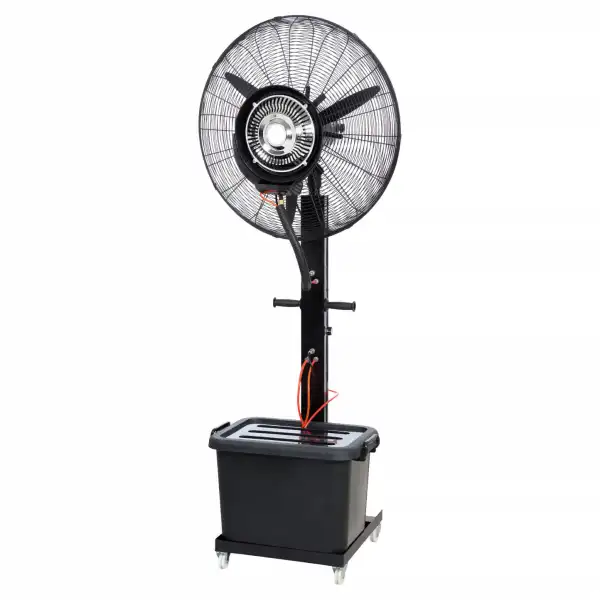
Misting fans are an innovative cooling solution that combines the benefits of traditional fans with the cooling effects of water mist.
These fans are particularly effective in outdoor settings or in dry climates where the added moisture can be refreshing and help reduce overall temperatures.
How They Work
- Cooling Mechanism: Misting fans emit a fine spray of water along with the air flow. The mist evaporates as it encounters the hot air, leading to a significant reduction in temperature.
- Ideal for Outdoor Use: They are a popular choice for patios, poolside areas, and outdoor events, providing a cooling mist that can make hot days more bearable.
Types and Designs
- Portable and Stationary Models: Misting fans come in various sizes, from portable units that can be moved around easily to larger, more powerful stationary models for extensive coverage.
- Integrated Water Systems: Some models come with their own built-in water tanks, while others can be connected to a continuous water source.
Features
- Adjustable Settings: Many misting fans allow control over the fan speed and mist volume, enabling users to customize the cooling effect according to their preferences.
- Oscillation: Like many traditional fans, misting fans often feature oscillation to distribute cool air and mist over a wider area.
Usage Considerations
- Ideal Climates: Misting fans are most effective in dry climates where the added humidity is beneficial. In humid environments, the additional moisture may not evaporate as efficiently, reducing the cooling effect.
- Outdoor and Well-Ventilated Areas: Given their water usage, these fans are best used in outdoor or well-ventilated indoor areas to avoid excess moisture accumulation.
Safety and Maintenance
- Electrical Safety: It’s important to ensure that the fan is designed for outdoor use with proper waterproofing and electrical safety features.
- Regular Maintenance: Regular cleaning and maintenance are required to prevent clogging in the misting nozzles and to ensure the fan operates effectively.
Industrial Fans
Industrial fans are heavy-duty fans designed for large-scale air circulation in industrial and commercial settings.
They are essential in managing air quality, temperature, and humidity in environments like factories, warehouses, and large-scale workshops.
Types and Applications
- Axial Fans: Common in industrial settings, these fans move air parallel to the fan shaft. They are ideal for general air circulation, cooling machinery, or ventilating large areas.
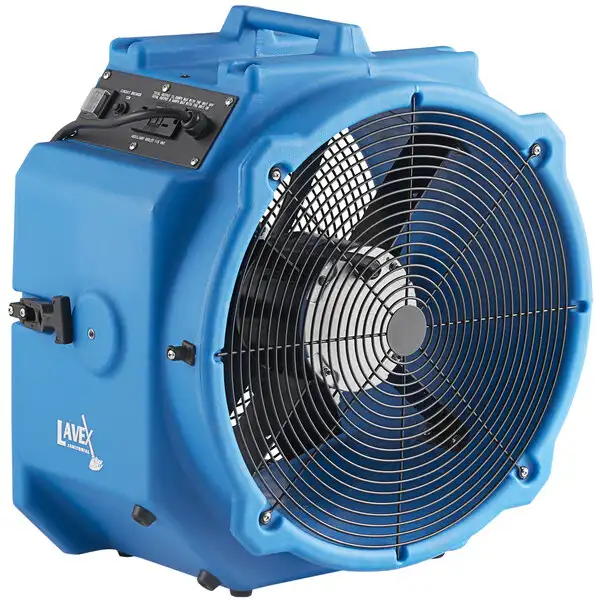
- Centrifugal Fans: Often used for air pollution control systems, these fans are effective in moving air against high resistance. They are ideal for processes that require air to move through ducts or along specific pathways.
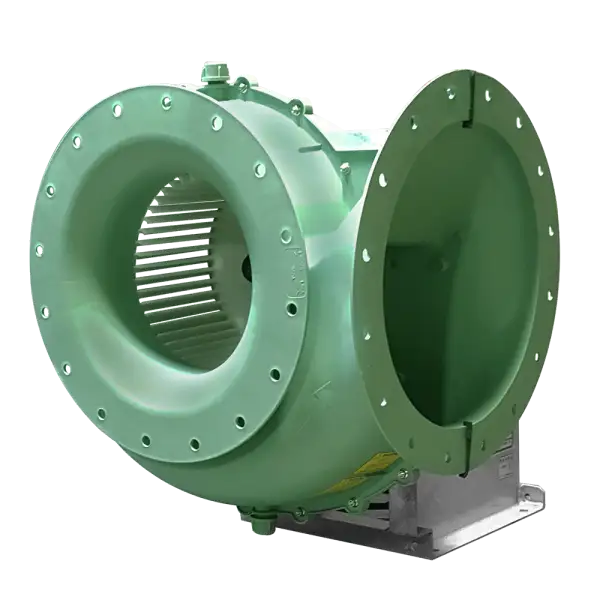
- High-Volume Low-Speed (HVLS) Fans: These large ceiling fans are designed to move large amounts of air at low speeds, providing effective air circulation in vast spaces like warehouses and manufacturing plants.
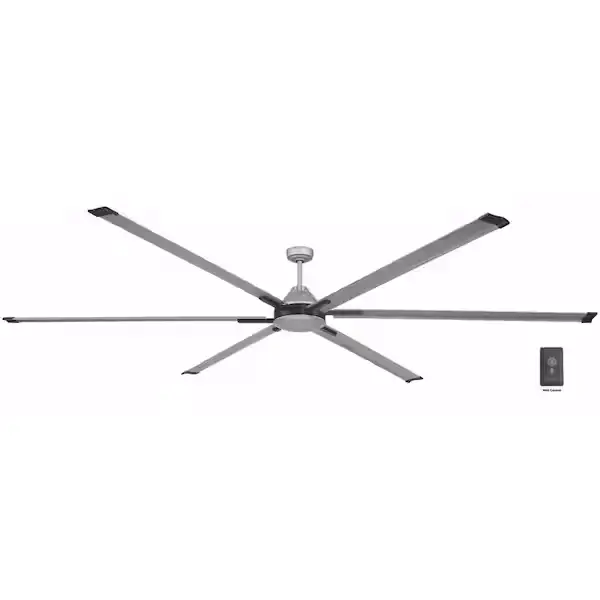
Features and Design
- Robust Construction: Industrial fans are built to withstand harsh conditions, including high temperatures, humidity, and dusty or dirty environments.
- High Performance: These fans are capable of moving large volumes of air, crucial for ventilation, cooling, and air quality control in industrial spaces.
- Customizable Designs: Many industrial fans can be customized in terms of size, materials, and specific features to meet the unique needs of different industrial applications.
Safety and Efficiency
- Safety Features: Given their size and power, industrial fans often come with safety features like guards and shut-off systems to protect workers.
- Energy Efficiency: Modern industrial fans are designed to be energy-efficient, reducing operational costs while maintaining high performance.
Installation and Maintenance
- Professional Installation: Given their size and complexity, the installation of industrial fans typically requires professional expertise.
- Regular Maintenance: Industrial fans require regular maintenance to ensure they remain efficient and functional, which includes cleaning, lubrication, and inspection for wear and tear.
Whole-house Fans
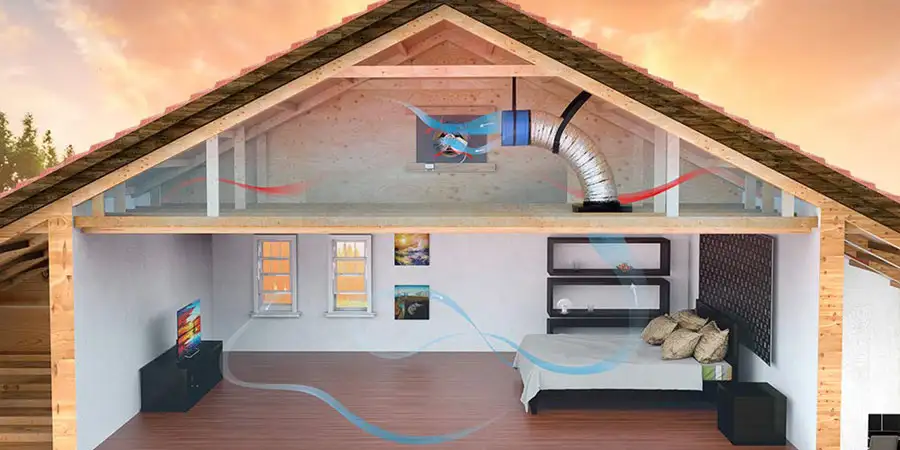
Whole-house fans are large ventilation fans designed to cool an entire home.
They are typically installed in the attic and work by drawing cooler outdoor air through open windows and doors, circulating it throughout the house, and then exhausting it through the attic and roof.
Functionality and Efficiency
- Cooling Mechanism: These fans are most effective in the evening and early morning when outdoor temperatures are lower. They quickly pull in cool air and flush out hot air trapped inside the home.
- Energy Efficiency: Whole-house fans are a cost-effective alternative to air conditioning, especially in regions with cooler nights and moderate climates.
Installation and Operation
- Attic Installation: Proper installation in the attic is crucial for optimal performance. It’s often recommended to have them professionally installed to ensure correct placement and venting.
- User Control: Typically operated with a switch or a timer, whole-house fans can be run for a period when outdoor temperatures are most favorable.
Benefits
- Reduced Air Conditioning Costs: By effectively cooling homes, these fans can significantly reduce the need for air conditioning, leading to lower energy bills.
- Improved Air Quality: They help in ventilating the house, reducing indoor pollutants and providing fresher air.
Considerations
- Appropriate Climate: Whole-house fans are most effective in areas where there is a significant temperature drop in the evening.
- Window Management: Homeowners need to open windows when the fan is in operation to facilitate proper air flow and prevent negative pressure issues.
Maintenance
- Regular Inspection: It’s important to inspect and maintain these fans regularly, ensuring that the venting system is clear and the fan is functioning properly.
Centrifugal Fans

Centrifugal fans, also known as blowers, are widely used in various residential, commercial, and industrial applications for moving air or gases.
These fans are characterized by their radial flow direction, where air enters along the axis of the fan and is expelled at a 90-degree angle.
Design and Mechanics
- Rotary Blades: The fan consists of a set of rotating blades enclosed within a casing. These blades draw air into the fan and then push it out radially, using centrifugal force.
- Different Blade Configurations: There are various blade configurations, such as forward-curved, backward-curved, and straight radial blades, each offering different performance characteristics.
Applications
- Air Purification and Ventilation Systems: Often used in HVAC systems to move air through ducts, aiding in heating and cooling.
- Industrial Processes: In industrial settings, they are used for air pollution control, pneumatic conveying, and in processes requiring high-pressure airflow.
Advantages
- High Pressure: Capable of generating high air pressure, making them suitable for systems with high resistance, like air filtration systems.
- Versatility: They can handle a wide range of air volumes and pressures, and are suitable for handling particulate-laden or moist air.
Installation and Operation
- Space Requirements: Typically require more space than axial fans due to their design.
- Noise Levels: Can be noisier than other fan types, depending on the application and design.
Efficiency and Maintenance
- Energy Efficiency: Modern centrifugal fans are designed to be energy-efficient, though efficiency can vary based on the specific application and fan design.
- Maintenance Needs: Regular maintenance is important to ensure optimal performance and may include cleaning, lubrication, and checking for wear and tear.
Variable Pitch Fans
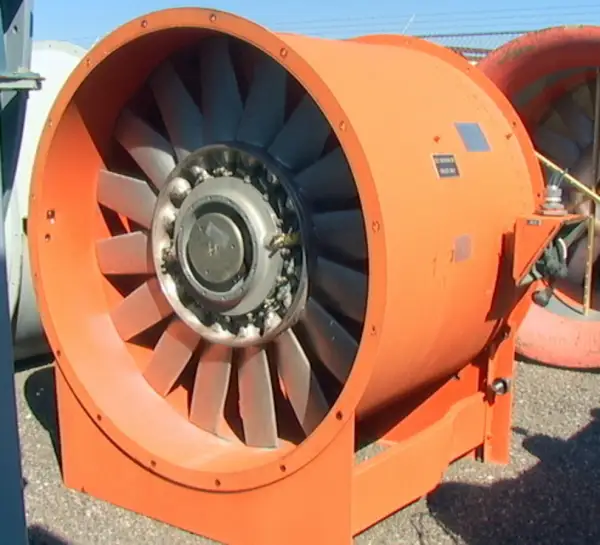
Variable pitch fans are a specialized type of fan where the angle of the blades can be adjusted while the fan is in operation.
This feature allows for a dynamic control of air flow and pressure, making them highly adaptable to varying conditions and requirements.
Design and Functionality
- Adjustable Blades: The key characteristic of these fans is their ability to change the pitch of the blades. This adjustment can be made manually or automatically, depending on the design.
- Dynamic Air Flow Control: By altering the blade angle, these fans can adapt to changing airflow requirements, making them highly efficient for processes that have varying air movement needs.
Applications
- Industrial Processes: Often used in industrial settings where the demand for ventilation or cooling can change rapidly, such as in power generation, manufacturing plants, and HVAC systems.
- Customizable Performance: Ideal for situations where precise control over air flow, pressure, and volume is needed.
Advantages
- Energy Efficiency: Variable pitch fans can be more energy-efficient as they allow for the adjustment of airflow without changing the fan speed or power consumption significantly.
- Flexibility: They offer greater flexibility and control compared to fixed-blade fans, adapting to different operational conditions without the need for multiple fans or complex systems.
Installation and Maintenance
- Complexity: These fans are more complex in design than standard fans, which can make installation and maintenance more challenging.
- Maintenance Requirements: Regular maintenance is crucial to ensure the mechanisms that adjust the blade pitch are functioning correctly.
Considerations
- Cost: Variable pitch fans can be more expensive than fixed-blade fans due to their added complexity and control mechanisms.
- Training and Operation: Proper training may be required for operators to fully utilize the capabilities and adjustments of these fans.
Advantages and Disadvantages of Different Types of Fans
Fans are a crucial element in maintaining comfort in various settings.
Each type of fan, from traditional ceiling fans to innovative bladeless models, has its own set of advantages and disadvantages.
Understanding these can help in selecting the right fan for specific needs and environments.
Ceiling Fans
- Advantages: Wide coverage, energy-efficient for cooling larger areas, variety of designs.
- Disadvantages: Permanent installation, not portable, and not as effective in very high ceilings without down rods.
Pedestal Fans
- Advantages: Portable, adjustable height and angle, effective for cooling specific areas.
- Disadvantages: Can be noisy, occupies floor space, and might not blend well with certain interior decors.
Table Fans/Desk Fans
- Advantages: Highly portable, direct cooling, suitable for small spaces or personal use.
- Disadvantages: Limited area coverage, not ideal for large rooms, and can be less durable.
Rechargeable Fans
- Advantages: Highly portable, cordless operation, versatile charging options, additional features like LED lights.
- Disadvantages: Limited battery life, potentially weaker airflow, requires regular maintenance, higher initial cost.
Floor Fans
- Advantages: Powerful airflow, portable, suitable for larger rooms or outdoor spaces.
- Disadvantages: Can take up floor space, potential safety hazard if not placed securely.
Tower Fans
- Advantages: Aesthetic design, space-saving, often come with additional features like ionizers.
- Disadvantages: Sometimes less powerful than traditional fans, can be more expensive.
Exhaust Fans
- Advantages: Excellent for moisture and odor removal, essential for bathrooms and kitchens.
- Disadvantages: Requires installation, not for general cooling, limited to specific areas.
Wall-Mounted Fans
- Advantages: Saves floor space, effective air circulation, can be directed where needed.
- Disadvantages: Fixed position, installation required, not as portable.
Window, Box, and Cabinet Fans
- Advantages: Specific to certain applications like enhancing HVAC efficiency or cooling specific areas.
- Disadvantages: Limited in versatility, installation might be required, not suitable for all spaces.
Bladeless Fans
- Advantages: Safe, modern design, often quieter than traditional fans.
- Disadvantages: Typically more expensive, may lack the airflow power of blade fans.
Misting Fans
- Advantages: Effective outdoor cooling, especially in dry climates, adds moisture to the air.
- Disadvantages: Not suitable for indoor use or high-humidity areas, requires water source.
Industrial Fans
- Advantages: High power and efficiency for large spaces, durable.
- Disadvantages: Not suitable for home use, can be noisy, requires significant space.
Hand Fans
- Advantages: Portable, no energy cost, can be used anywhere.
- Disadvantages: Manual operation, limited cooling effect, not practical for cooling large areas.
Whole-house Fans
- Advantages: Efficient for cooling entire homes, can reduce air conditioning costs.
- Disadvantages: Installation can be complex, not effective in humid climates, requires open windows.
Centrifugal Fans
- Advantages: Powerful, suitable for air pollution control and HVAC systems.
- Disadvantages: Larger and noisier, requires more space, not for general home use.
Variable Pitch Fans
- Advantages: Adjustable airflow, energy-efficient, adaptable to varying needs.
- Disadvantages: More complex and expensive, requires maintenance and knowledgeable operation.
Each fan type offers a unique blend of advantages and disadvantages, making it important to consider the specific needs of the environment and the primary purpose of the fan before making a choice. From enhancing air quality to providing focused cooling, the variety of fans available ensures there is a solution for almost every scenario.
Technological Developments in Fan Technology
The evolution of fan technology has been marked by significant advancements, leading to increased efficiency, enhanced features, and better integration with modern lifestyles.
These developments have transformed fans from simple air-moving devices into sophisticated home comfort appliances.
Energy Efficiency
- Improved Motor Designs: Modern fans often feature energy-efficient motors, like brushless DC motors, which consume less power than traditional motors.
- Smart Controls: Integration with smart home systems allows fans to be controlled for optimal energy usage, adjusting speeds based on room occupancy or time of day.
Advanced Control Systems
- Remote Control Operation: Many fans now come with remote controls, making it easier to adjust settings without physical interaction.
- Programmable Timers and Modes: Features like sleep timers and nature-inspired airflow modes enhance user convenience and comfort.
IoT and Connectivity
- Wi-Fi Enabled Fans: Fans can now be connected to the internet, allowing control via smartphones or voice assistants like Amazon Alexa or Google Assistant.
- Integration with Smart Home Ecosystems: Fans can be part of a larger smart home ecosystem, automatically turning on or off based on pre-set conditions like temperature or humidity levels.
Design Innovations
- Bladeless Technology: Innovations like Dyson’s bladeless fans offer a safer and quieter cooling solution, revolutionizing the design and functionality of fans.
- Customizable Aesthetics: Fans are being designed with aesthetics in mind, featuring customizable LED lights or designs that complement modern home decor.
Air Purification
- Fans with Built-in Air Purifiers: Some advanced models combine air circulation with filtration, removing pollutants and allergens from the air.
- Ionizing Fans: These fans not only cool the air but also release ions to purify the environment, reducing airborne dust and bacteria.
Environmental Adaptability
- Humidity and Temperature Sensors: High-end fans can adjust their operation based on the humidity and temperature, providing optimal cooling and air quality.
Health and Wellness Focus
- Reduced Noise Levels: Modern fan designs focus on reducing operational noise for a more comfortable environment, especially in bedrooms and offices.
- Air Quality Monitoring: Some fans are equipped with air quality sensors, providing feedback and automatically adjusting settings for improved air quality.
These technological developments in fans not only enhance the user experience but also contribute to energy conservation and a healthier living environment.
As technology continues to advance, we can expect further innovations that will make fans even more integral to our daily comfort and well-being.
Choosing the Right Fan
Selecting the appropriate fan for your needs involves considering various factors, from the size of the space to specific features that enhance functionality and comfort.
Here’s a guide to help you make an informed decision:
Consider the Room Size
- Large Rooms: For bigger spaces like living rooms or large offices, ceiling fans or large pedestal fans are ideal. HVLS (High Volume, Low Speed) fans can also be considered for industrial-sized areas.
- Small to Medium Rooms: Desk fans, tower fans, or wall-mounted fans are more suitable for smaller spaces or bedrooms.
Purpose and Placement
- General Cooling: Ceiling or floor fans are great for general air circulation.
- Targeted Cooling: Desk or pedestal fans are better if you need focused cooling.
- Outdoor Use: Misting fans are excellent for patios, while industrial fans can be used in large, open workspaces.
- Space Constraints: If space is limited, consider wall-mounted or tower fans.
Features and Functionality
- Speed Settings: More speed settings offer greater flexibility in controlling airflow.
- Oscillation: For wider air distribution, look for fans with an oscillation feature.
- Noise Level: In bedrooms or offices, a fan with a quiet operation is preferable.
- Energy Efficiency: Fans with energy-saving modes or efficient motors can help reduce electricity bills.
Advanced Features
- Remote Control: For convenience, choose a fan with a remote control.
- Smart Features: Fans with smart home integration can be controlled via apps or voice commands.
- Air Purifying: In environments where air quality is a concern, consider fans with built-in air purifiers.
Aesthetics
- Design: The fan should complement your room’s décor. Bladeless fans, for instance, offer a modern look.
- Size and Color: Ensure the fan’s size is proportionate to the room, and its color matches or enhances the room’s aesthetic.
Budget
- Cost vs. Quality: While budget is an important consideration, investing in a slightly more expensive fan can offer better durability and efficiency in the long run.
Safety and Maintenance
- Safety Features: Especially important if you have children or pets. Bladeless fans or those with protected blades are safer options.
- Ease of Maintenance: Consider how easy it is to clean and maintain the fan, as regular maintenance can prolong its lifespan and ensure optimal performance.
By carefully considering these aspects, you can choose a fan that not only meets your cooling needs but also fits well with your lifestyle, room aesthetics, and budget.



